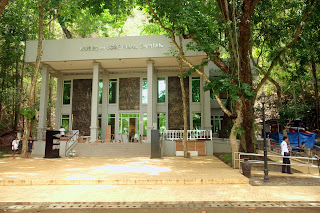 |
| The shrine is located along a bay |
 |
| The museum |
 |
| the "Lover's Rock" |
 |
| A view of the bay from the rock |
 |
| The comfort room |
Inside the house is furniture of Spanish colonial era design which is made of indigenous hardwoods. In the living room are chairs and a center table. The seat of the chairs and the top of the table are made of woven rattan that is attached to the wooden frames. There are two chests in the sides of the wall. Outside the only room is an empty book shelf, a wooden wall mounted hooks, a work table and chair and a set of two chairs with a small round table.
In the bedroom is a double sized four poster bed with mattress and white curtains around it. By the bed is a chest and a chair in the corner of the room. There is a cabinet with a mirror on one of its doors and a dresser with a small mirror on top. A chair with a raised seat pairs the dresser.
The cottage for the kitchen is outside the house. There is a stove and the kitchen utensils composed of pots and pans that are made of clay. A pipe of bamboo is reached to the sink.
Aside from the casa residencia, or the residential house, faithful replicas of the original structures which Rizal built are also reconstructed. There is the casitas de salud, a pair of two huts, one for male and the other for female that served as a dormitory for out of town patients. There is the casa redonda or round house. This cottage on stilt is not round but rather octagonal in shape. It was there that Rizal conducted an eye surgery on George Taufer, the adoptive father of Josephine Bracken and on Doña Josefa, his mother. There is the Casa cuadrada or square house which was built as a workshop and secondary dormitory for Rizal’s students. And there is the chicken coop or hen house which perched on a slope near Rizal’s house.
 |
| Casitas de Salud |
 |
| Casa Redonda |
The Divine Mercy Shrine of El Salvador, Misamis Oriental https://lapasan-myblognoel145.blogspot.com/2014/09/the-divine-mercy-shrine-of-el-salvador.html
Fort Pilar, Zamboanga City https://lapasan-myblognoel145.blogspot.com/2022/08/fort-pilar-zamboanga-city.html
Siargao, a Tropical Island Paradise in the Pacific https://lapasan-myblognoel145.blogspot.com/2018/04/siargao-tropical-island-paradise-in.html
Camiguin Island: a Tourist Destination https://lapasan-myblognoel145.blogspot.com/2012/08/camiguin-tourist-destination-island.html
Tinago Falls, Iligan City, Philippines https://lapasan-myblognoel145.blogspot.com/2012/08/tinago-falls-iligan-city-philippines.html
The Del Monte Pineapple Plantation in Bukidnon, Philippines https://lapasan-myblognoel145.blogspot.com/2012/08/the-del-monte-pineapple-plantation-in.html


























No comments:
Post a Comment